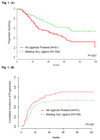KIR and HLA genotypes are associated with disease progression and survival following autologous hematopoietic stem cell transplantation for high-risk neuroblastoma
- PMID: 19934297
- PMCID: PMC2788079
- DOI: 10.1158/1078-0432.CCR-09-1720
KIR and HLA genotypes are associated with disease progression and survival following autologous hematopoietic stem cell transplantation for high-risk neuroblastoma
Abstract
Purpose: NK cells exhibit cytotoxicity against neuroblastoma. Gene polymorphisms governing NK cell function, therefore, may influence prognosis. Two highly polymorphic genetic loci instrumental in determining NK cell responses encode the NK cell killer immunoglobulin-like receptors (KIR) and their class I human leukocyte antigen (HLA) ligands. We hypothesized that patients with a "missing ligand" KIR-HLA compound genotype may uniquely benefit from autologous hematopoietic stem cell transplantation (HSCT).
Experimental design: One hundred sixty-nine patients treated with autologous HSCT for stage IV neuroblastoma underwent KIR and HLA genotyping. Patients were segregated according to the presence or absence of HLA ligands for autologous inhibitory KIR. Univariate and multivariate analyses were done for overall and progression-free survival.
Results: Sixty-four percent of patients lacked one or more HLA ligands for inhibitory KIR. Patients lacking a HLA ligand had a 46% lower risk of death [hazard ratio, 0.54; 95% confidence interval (95% CI), 0.35-0.85; P = 0.007] and a 34% lower risk of progression (hazard ratio, 0.66; 95% CI, 0.44-1.0; P = 0.047) at 3 years compared with patients who possessed all ligands for his/her inhibitory KIR. Among all KIR-HLA combinations, 16 patients lacking the HLA-C1 ligand for KIR2DL2/KIR2DL3 experienced the highest 3-year survival rate of 81% (95% CI, 64-100). Survival was more strongly associated with "missing ligand" than with tumor MYCN gene amplification.
Conclusion: KIR-HLA immunogenetics represents a novel prognostic marker for patients undergoing autologous HSCT for high-risk neuroblastoma.
Conflict of interest statement
There are no relevant conflicts of interest to disclose.
Figures
References
-
- Brodeur G, Maris J, editors. Neuroblastoma. 5 ed. Philadelphia: Lippincott Company; 2006.
-
- Simon T, Spitz R, Faldum A, Hero B, Berthold F. New definition of low-risk neuroblastoma using stage, age, and 1p and MYCN status. J Pediatr Hematol Oncol. 2004;26:791–796. - PubMed
-
- Castriconi R, Dondero A, Corrias M, Lanino E, Pende D, Moretta L, et al. Natural killer cell-mediated killing of freshly isolated neuroblastoma cells: critical role of DNAX accessory molecule-1-poliovirus receptor interaction. Cancer Res. 2004;64:9180–9184. - PubMed
Publication types
MeSH terms
Substances
Grants and funding
LinkOut - more resources
Full Text Sources
Other Literature Sources
Medical
Research Materials


